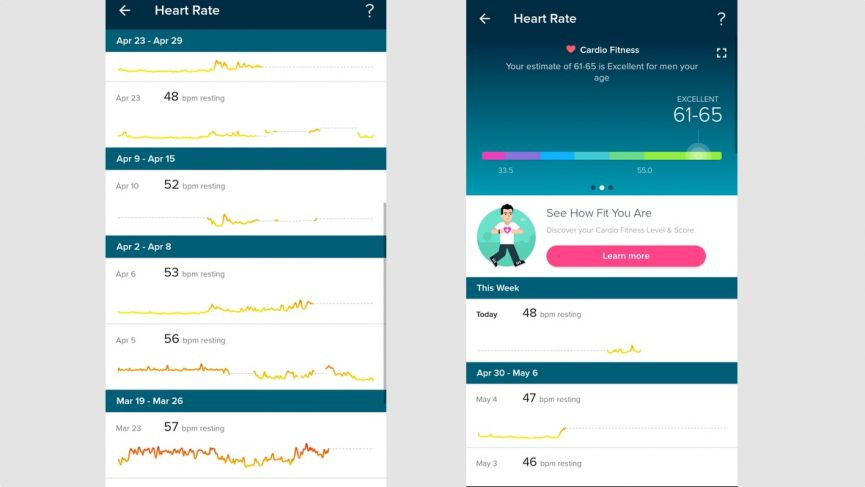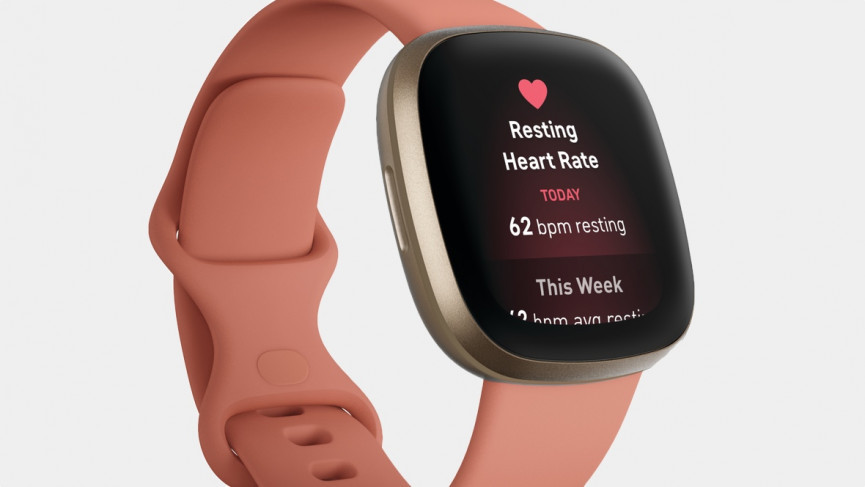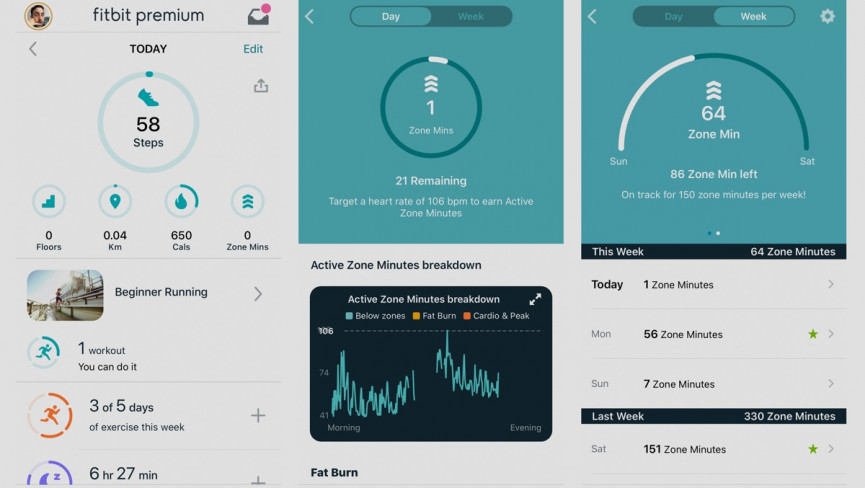
Tracking heart rate is a huge feature of Fitbit's smartwatches and fitness trackers – and drives the data we demand from our wearables. But how does Fitbit track heart rate, what features does it power, and crucially, is it accurate?
Thanks to the in-built heart rate monitor found in the likes of the Fitbit Charge 5, the new Fitbit Versa 4 and Fitbit Sense 2 (or any of the rest of the Fitbit clan) you're able to gauge not only your heartbeat activity during workouts, but also tap into wellness features and some of the best sleep tracking in the business.
With the arrival of its Sense watch and its new PurePulse 2.0 sensor technology, Fitbit is also venturing deeper with the level of heart rate monitoring.
We get stuck into how it all works and why you'd want to try it out:
> Read our guide to the best Fitbit trackers and smartwatches
15 ways Fitbit devices use your heart rate data
Fitbit
Fitbit Health Metrics dashboard
By tracking your heart rate, Fitbit can better establish facts about your body and offer better insights. Fitbit uses its heart rate sensor for:
- Real-time 24/7 heart rate
- Workout heart rate and automatic workout detection
- Resting heart rate
- Average heart rate
- Heart rate variability (Health Metrics Dashboard)
- Calorie burn information
- Heart rate via sleep for Sleep Stages
- VO2 Max via Cardio Fitness Score
- Breathing via Relax app
- Active Zone Minutes
- Workout Intensity Maps
- High/low heart rate notifications
- Detecting signs of atrial fibrillation (via ECG on Fitbit Sense/Fitbit Charge 5)
- Stress management score
- Daily Readiness Score (Fitbit Premium only)
How does Fitbit measure heart rate?
Wareable
Fitbit Charge 5 heart rate sensor
Similar to how we covered the tech for the Apple Watch heart rate monitor, let's give a quick breakdown of how pretty much all wrist-based heart rate monitoring works.
Photoplethysmography essentially works upon one simple premise: blood is red because it reflects red light and absorbs green light. So by using green LEDs and pairing them with photodiodes, Fitbit uses its own in-house PurePulse technology to detect the amount of blood flowing through the wrist.
When your heart beats, this flow, and as a result, the green light absorbed is greater. These lights are then flashed hundreds of times per second to gain the most accurate BPM (beats per minute) data.
Naturally, while every company dabbling with this optical sensor technology is working from the same blueprint, the accuracy of the readings will come down to how each company's algorithms interpret the data.
How accurate is Fitbit heart rate?
Fitbit
Fitbit Sense heart rate sensor
Fitbit's Versa 3 and Sense watches ushered in PurePulse 2.0, which aims to improve the performance of that sensor technology. It's achieving that by increasing the number of light transmitters and receivers that are used to get that data. It means that Fitbit can now use 6 independent optical channels across a larger surface area to improve the reliability of the data.
Dr. Shelten Yuen, vice president of research at Fitbit says that the improved setup yields an average signal to noise ratio increase of 56% for running exercises.
Wrist movement or motion is one of the biggest obstacles to providing an accurate reading. Fitbit thinks it's devised a way to improve performance when that becomes a factor.
Fitbit accuracy: Our testing
Like with any optical heart rate solution, Fitbit's PurePulse technology is solid, but not without its issues.
We have extensively tested all of the latest Fitbit devices and validated the sensor against control devices, heart rate straps, and manual spot readings taken by physicians.
In our testing, resting and walking heart rates were measured with a high degree of accuracy.
Likewise, steady workouts (such as running and cycling) were also well-tracked. We would also say that anyone relying on the data for training purposes, such as running in zones, should use a chest strap sensor. But we have found Fitbit data to be largely accurate against such sensors.
When fluctuating between high heart rate and low heart rate during interval training can often prove to be problematic for an optical heart rate monitor to keep up with. However, this is a problem shared by all optical sensors.
How to wear a Fitbit for better accuracy
Fitbit
Naturally, as with any wrist-based monitor, you'll also need to make sure the back of the watch is touching the skin at all times, while also ensuring it isn't strapped too tightly onto your wrist.
If you sense your Fitbit device isn't quite tracking your heart rate correctly, there are a couple of things to keep in mind.
Firstly, a good tight fit is extremely important as light leaking in from the sides of your watch will disrupt the signal.
When you're not exercising, wear your device a finger's width below your wrist bone.
And when you are exercising, consider wearing the device slightly higher on your wrist for more accurate readings, since some exercises will cause your wrist to move frequently.
ECG technology explained
Wareable
ECG feature on Fitbit Charge 5
Fitbit additionally offers an ECG sensor on its Charge 5 and Sense smartwatch, matching the Apple Watch and Samsung's latest smartwatches to offer medical-grade heart rate readings.
It adopts the same method of measuring electrical signals from your heart when users place their fingers on the case, to take an EKG.
ECG readings are different from the usual heart rate readings because instead of determining the bpm of your heart, it analyses the regularity of each beat.
The ECG sensor is designed to pick up irregular heart rate rhythms, that can be a sign of atrial fibrillation (Afib). Afib is a huge underlying cause of strokes and other morbidities in the US – and most sufferers have no idea they have it.
When you take a reading, the device will tell you whether your rhythm is normal (sinus) or AFib. You can also get a EKG reading to show your doctor, which you'll find in the Fitbit app.
Aside from spot-checking your heart health, it's also enormously helpful for people with symptoms that appear and disappear to take an ECG when they feel unwell. That can be a more helpful way to talk to your doctor.
How to view your heart rate on a Fitbit
Wareable
Heart rate graphs in Fitbit app
Below we'll get into the intricacies of the heart rate monitor, but it's worth pointing out how you can view your heart rate data, too.
Depending on the device itself, you should be able to see your current BPM on the home screen or by swiping. For detailed info from your exercise or on resting heart rate, you'll need to head to the Fitbit app's dashboard and tap through to the Heart Rate section and select the day you want to view. The same also applies to the Fitbit web app.
Resting heart rate
Fitbit
Heart rate tracking isn't just about exercise. Fitbit's trackers are also able to keep track of your resting heart rate — a metric which refers to your heart rate when you're completely still.
Why is resting heart rate important? Well, typically fitter, healthier people will have lower resting heart rates. And as you get fitter, yours will decline too. So it can be a great measure of improvements in lifestyle.
And in addition, rises and spikes in resting heart rate can be a sign of illness or fatigue – so it should be one of the key measurements to keep an eye on in the Fitbit dashboard.
To see your resting heart rate, you can tap the panel on the Fitbit dashboard which will show you day-by-day.
But you can also see your RHR in the Health Metrics dashboard, with normalized personal ranges, so you can look out for spikes/changes at a glance.
Active Zone Minutes
Wareable
Fitbit's new metric is called Fitbit Active Zone minutes, which is available on the Fitbit Charge 5, Fitbit Versa, and Sense smartwatches. Active Minutes have always been a fixture of your daily goals, where you needed to aim for 30 minutes of brisk walking, or more, per day. But Active Zone Minutes take things to the next level
The premise is simple – the World Health Organisation and American Heart Association recommend 150 minutes of exercise per week, or 75 minutes of vigorous exercise.
Fitbit now uses heart rate zones to award these minutes to a goal: if you get into the fat-burning zone for 1 minute you get 1 minute awarded.
Previously, this discriminated against more active people, who would get the same reward for a HIIT workout than someone for a brisk walk. So if you get into the Cardio or Peak zones, you get 2 minutes awarded for every minute of exercise.
What's more, your zones are personal. That's because they are calculated from your resting heart rate and your max HR (based on age - 200), and this has two benefits: first, your goal should be tailored to your fitness level. Secondly – as you get fitter you'll have to work harder to hit the goal.
> Read our full guide to using Active Zone Minutes.
VO2 Max (Cardio Fitness Score)
To access your score, simply head to the heart rate section of the Fitbit companion app and swipe the graph across. The higher your score, the better your fitness, and Fitbit will help determine where you sit on the scale by looking at your age, gender, and resting heart rate.
Workout intensity maps
Wareable
This is another fitness-focused feature that seeks to go beyond showing you post workout the heart rate zones you spent the most time in. For outdoor activities like running, you can see where you've hit different heart rate zones during the route. So you can establish where you have been working your hardest during that activity.
To view workout intensity maps, simply go into a logged workout, and above the mapped route you can toggle to see heart zones plotted over your route.
Fitbit heart rate zones
Wareable
Heart rate zones are essentially groupings, which allow you to adjust the intensity of your training based upon how long you spend in certain stages or zones.
When you set up a Fitbit account you'll be assigned your maximum heart rate, which is configured by the usual method — 220 BPM minus your age — and from there, your heart rate zones are also established.
Essential reading: How to train with heart rate zones
At the top is what Fitbit labels as your Peak Zone, which means your heart rate is above 85% of its maximum. Next below is your Cardio Zone, which covers the ground between 70% and 84%, before scaling down to the the Fat Burn Zone when your heart is pumping at between 50% and 69% of its maximum. Anything below 50% of your maximum heart rate is considered Out Of Zone.
How to customize Fitbit heart rate zones
It's all well and good knowing about your heart rate zones, but it's also nice to have a bit of control over them. And there are two ways to customize them.
If you're working from the Fitbit app, head to Account from the app dashboard and scroll down to Heart Rate Zones in settings. From there, you're able to add a custom zone and also adjust your max heart rate.
To change the same things from the Fitbit web app, head to the dashboard, select the gear icon, select Settings, and then Personal Information.
Fitbit SpO2 sensor explained
The newest Fitbit devices - the Charge 5, Versa, Sense, Luxe - come with an SpO2 sensor for tracking blood oxygen levels.
This data has recently been enabled in the Fitbit app, and blood oxygen levels are now read in the Estimated Oxygen Variation graph.
It's used in multiple places, but you can see your nightly SpO2 in your sleep data. Spikes can let Fitbit alert users if it thinks they might be suffering from sleep apnea. The graph can only be seen by Fitbit Premium users.
But you can get an idea of nightly blood oxygen saturation in the Health Metrics Dashboard, which can be accessed by non-Premium users.
Using heart rate tracking to keep calm
Wareable
Heart rate variability, which is calculated by looking at the time between heartbeats, is another measurement used by Fitbit to keep track of your heart. However, since this is focused on tracking fluctuations, things like a user's age, body position, the time of day, and health status can all affect readings.
Fitbit's Relax app, available on the Charge 3, Charge 4, Ionic, Versa and Sense measures the beat-to-beat changes in order to recommend a personalized breathing pattern during each guided breathing session.
However, these are more of a real-time way to get you to focus on relaxing, as opposed to something you view in the companion app and keep a track of in the long term. You're able to choose a session lasting either two or five minutes, and all you need to do is follow the circle on the screen for inhaling/exhaling. Sparkles will show after around 20 seconds if you're aligned to the device.
You can read more in our heart rate variability guide.
Working out calorie burn
Firstly, your Fitbit device will take into account your basal metabolic rate (BMR), which is the calories that burn by maintaining necessary body functions like breathing, heartbeat, and brain activity.
This BMR accounts for around half of your daily calories, with this estimated from the gender, age, weight and height you enter when setting up your device. And with the tracker resetting the stats at midnight, this is why you'll notice calories already burned when you wake up - you're still burning as you sleep. Naturally, Fitbit will also be adding on the calories you burn through activity.
If you're looking for more on this, we've gone into detail about how calorie burn estimates actually work.
Daily Readiness scores
This is a new feature that Fitbit has recently rolled out to the likes of the Fitbit Charge 5 and its Versa and Sense smartwatches and is also compatible with the Fitbit Luxe and Inspire 2. You need to have a full Fitbit Premium subscription to access the feature as well.
Daily readiness scores aim to give you a simple way of understanding whether you should tackle a tough day or take a rest day instead.
It does this primarily through tracking your sleep, but it pays close attention to heart rate variability measurements captured during sleep to generate that score. A high HRV number can indicate you may be in good shape to train hard and contribute to a high Readiness score. A low HRV, may be an indication of stress and strain and that indicates you need to take it easy, contributing to a low Readiness score.
How we test
